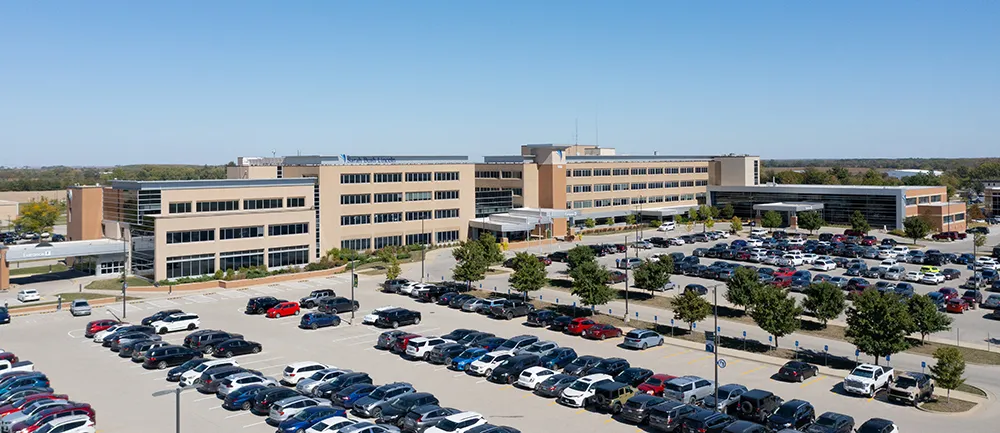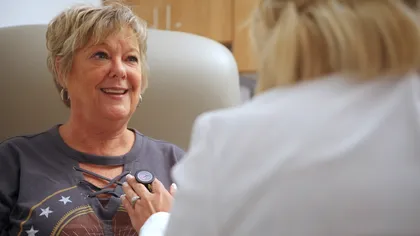
The History of Sarah Bush Lincoln Health System
Sarah Bush Lincoln Health System has distinguished itself time and time again as a healthcare provider, employer and community partner while remaining true to its mission over the years: to provide exceptional care for all and create healthy communities. Its leaders and staff have quickly responded to changes in the way healthcare is delivered, so area residents have the benefit of receiving excellent healthcare close to home.
1960s and 1970s
Sarah Bush Lincoln Health Center opened May 10, 1977 at a cost of $8 million. Planning for the regional facility began in 1968.
1980s
SBLHC added a $2.2 million Regional Cancer Center in 1989 and remodeled its Mental Health Unit. Outpatient care became a focus, and equipment became both less invasive and more accessible with the addition of magnetic resonance imaging (MRI) and mobile lithotripsy.
1990s
Outreach was a central focus. SBL expanded its footprint by opening patient care clinics in Casey, Neoga, Toledo, Sullivan, Arthur, Arcola, Charleston and Mattoon, and by completing a $25.5 million expansion and renovation project that added the Lumpkin Family Center for Health Education and the SBL Medical Office Pavilion.
An innovative Skilled Nursing Unit was added, as was an occupational medicine program, an employee assistance program, home health care and hospice services. The Health System also grew through significant physician recruitment efforts and multiple, community education programs that focused on health education and risk prevention.
2000s
The Outpatient Surgery Center, an expansion of the Medical Office Pavilion and a cardiac catheterization lab opened. Advances in technology allowed SBL to add “paperless” charting and “filmless” radiology services. Sarah Bush Lincoln’s many advances in technology and patient safety earned it numerous national awards beginning midway through the decade and continuing today.
2010s
SBLHC continued to invest in facilities and technology by completing a $48 million renovation to SBL, constructing Prairie Pavilion 2 medical office building, building a new Regional Cancer Center, and upgrading its medical records technology.
2020s
With the onset of COVID-19, SBL used its agility to meet the growing healthcare needs of the community and was a trusted source of care. It continued to see expanded growth in its southern market, with new acquisitions, clinic construction and renovation and the transfer of Fayette County Hospital to SBL, making it a two-hospital system.
For a more detailed look at the history of Sarah Bush Lincoln Health System, go to: The 1960s and 1970s, The 1980s, The 1990s, The 2000s, The 2010s & The 2020s,
The idea of building a hospital to serve the entire region of East Central Illinois began in 1968. At that time, there were two hospitals operating in Coles County: Mattoon Memorial Hospital (MMH) with 114 beds and Charleston Community Memorial Hospital (CCMH) with 65 beds. The boards of directors of both facilities were facing operational difficulties. While MMH was an overcrowded, out-of-date facility where patients were actually admitted to the hallways due to a lack of patient rooms, CCMH suffered from low admissions and too few physicians. In fact, there were only seven doctors on the active medical staff.
In March 1968, Robert Wright, chairman of the Mattoon Memorial Hospital Fact Finding Committee, recommended that the MMH board consider either expanding the existing hospital or building a new facility. Acting on this recommendation, the board hired the Chicago consulting firm of Jensen, Halstead and Rummel to perform a feasibility study. The study was of equal interest to Charleston Community Memorial Hospital, since it, too, faced serious operational difficulties. The scope of the feasibility study was therefore expanded to cover the health care needs of the entire region.
The results of the study were presented to the hospital boards in January 1969. It was estimated that upgrading MMH would cost $6.8 million, while a new hospital of approximately 200 beds could be built for $7 million. The firm recommended that a new, regional hospital be built between Mattoon and Charleston.
In direct response to that advice, the Charleston-Mattoon Area Medical Planning Council (CMAMPC) was formed. The CMAMPC was comprised of five members from each hospital. On the council were Drs. Leland McNeill and Wilfred Brunswick from the Mattoon Memorial Hospital medical staff and Robert Carlyle, Glen Hesler, and Robert Tweed from the board of Mattoon Memorial Hospital. Council members from the board of Charleston Memorial Hospital were Robert Baker, Robert Carlisle and Donald Mapes. Drs. L.R. Montemayor and G.D. Wright represented the Charleston Community Memorial Hospital medical staff.
The regional hospital project was the first large-scale joint effort of voluntary groups from both of the communities. The merger of the two hospitals would allow the sharing of services, personnel and experience, and thereby eliminate the duplication of services and expenses. Since the State government was attempting to regionalize healthcare services, the plan was an ideal solution.
In February 1969, Dr. Montemayor from the Charleston Medical Staff was named chairman of the Charleston-Mattoon Area Medical Planning Council. Support from the communities began to emerge, and the Mattoon Memorial Hospital Women’s Auxiliary donated $1,000 to the Charleston-Mattoon Area Medical Planning Council.
By April, the council had selected 19 land sites along Illinois Route 16 as possible locations for the new hospital, and the Mattoon Journal Gazette published the first editorial supporting the development of a facility located between the two towns.
In August 1969, the need and urgency for building a new hospital to serve the region became even more evident when the Mattoon and Charleston hospitals were surveyed by the Illinois Department of Public Health and the Mattoon-Charleston region was rated as being the sixth worst area for medical care in the State. Furthermore, a total of 103 patient beds from both facilities were found to be nonconforming to the Illinois Department of Public Health’s Fire and Safety Standards.
In October 1969, the Charleston-Mattoon Area Medical Planning Council expanded and appointed additional members. Among the new members were Richard Lumpkin, chairman of the Acute Care Committee; Dr. Emil Gritti and Virgil Judge, who were appointed to the Medical Personnel Recruitment and Education Committee; Dr. Stanley Thiel, who was on the Mental Health Committee; and Dr. Leland McNeill, who was on the Public Information Committee.
1970 proved to be a very busy and successful year for the development of the hospital. In January, Dr. Emil Gritti was selected as president of the Area Medical Planning Council and later that year a corporate charter was granted from the State of Illinois for the Area E-7 board. The board was developed to oversee the development, organization and administration of the new hospital. The initial board of directors for Area E-7 was: George Tankey, Clark Brogan, Dr. Mack W. Hollowell, Harley Holt, Victor Walk, Ralph Glenn and Bob Moore.
One of the first actions of the Area E-7 board was to request $8 million in government grants to be used for constructing the new hospital. Prior to the request, the State had ranked the Mattoon-Charleston region as 47th in line for acquiring building funds. This ranking was based on the earlier plans to expand existing facilities. A reevaluation of the region was conducted based on plans to construct a new, regional facility. Upon completion of the reevaluation, Area E-7 was ranked third in the State for construction funds.
A fund drive for the new facility was kicked off in June 1970. The fund drive for the new hospital had a goal of $2.5 million and was chaired by Melvin Lockard. In July, Charleston Community Memorial Hospital joined Mattoon Memorial Hospital in publicly giving full support for the new hospital. The Illinois Department of Public Health granted a license for the new hospital in October, and in December Richard Lumpkin was elected president of the Charleston-Mattoon Area Medical Planning Council.
That momentum continued into 1971. The board selected the architectural firm of Hewitt and Royer of Kansas City, Missouri to design and plan the new regional facility, and the Area E-7 board decided the new hospital would be named Sarah Bush Lincoln Health Center.
Sarah Bush Lincoln quickly became the top priority for hospital construction in the State. The federal government supported the project with a grant of $741,405, and the State pledged $1.6 million. Employees of the Charleston and Mattoon hospitals and the Douglas Living Center pledged to donate $75,000 to the new facility, the Mattoon Memorial Hospital Auxiliary pledged $50,000 and by the end of the fund drive in December, more than 58,000 area residents had contributed in excess of $3 million! In early 1972, the Area E-7 received notification of an additional $900,000 from the federal government’s Hill-Burton program.
A 75-acre tract of land located east of the Coles County airport and north of Illinois Route 16 was selected as the best location for the Health Center due to its central location and its proximity to Illinois Route 16 and Interstate 57. By the fall of 1972, road construction for the new Health Center had begun.
By 1973, the goal of building a new facility was starting to become a reality. The development phase began to move rapidly. In May, the Area E-7 board opened bids for the construction of the Health Center, and contracts for the construction were signed in July. Construction of the new Health Center began in August.
In order for Sarah Bush Lincoln to become a reality, it was necessary for certain legislative changes to occur; Mattoon Memorial Hospital and Charleston Community Memorial Hospital had to agree to cease operations and merge assets and resources once Sarah Bush Lincoln was opened. In April 1973, the State Legislature passed a bill allowing the merger and transfer of assets from the MMH to Sarah Bush Lincoln Health Center. In November, the residents of Mattoon voted on a referendum that allowed for the transfer and requested the discontinuance of the tax that supported MMH. Voters approved the proposal 2,979 to 1,216.
In March 1976, with the construction of the new Health Center approaching the final phases, CCMH voted to join MMH in merging into Sarah Bush Lincoln Health Center. With the consolidation of both area hospitals complete, the residents of East Central Illinois anticipated the opening of the new Health Center.
On Mother’s Day, May 10, 1977, Sarah Bush Lincoln Health Center became a reality. An open house was held, and thousands of area citizens waited in lines to see the new facility. After nine years of planning, development and construction, East Central Illinois residents were the owners of the newest and most up-to-date hospital in the area. The results of having a modern facility were evident soon after the opening. The new facility was a key factor in attracting new physicians to the area. As the number of physicians grew, so did the number of specialties represented. Soon Sarah Bush Lincoln had a medical staff that included specialists in neurology, cardiology, orthopedics, otorhinolaryngology and vascular surgery. Top
The Health Center's governing board, administrators and staff continually looked for ways to maintain Sarah Bush Lincoln's status as a premier provider of healthcare. Reevaluating and expanding its services to better meet the needs and wishes of residents of East Central Illinois become its modus operandi, even as a young organization.
The installation of a permanent computerized tomography (CT) scanner spoke volumes about how technologically advanced the Health Center was. Likewise, the Ambulatory Care Center opened in direct response to changes in the healthcare field. The center enabled patients to receive advanced testing procedures and surgical care on an outpatient basis, thereby allowing them to resume their normal activities after brief recoveries. The move away from predominantly inpatient care to ambulatory care represented a sea change in the healthcare industry as a whole, as it actively sought ways to preserve shrinking healthcare dollars and deliver care in a more consumer-focused way.
In February 1989, Sarah Bush Lincoln held grand openings for two new services: a $2.2 million Regional Cancer Center and a newly remodeled Mental Health Unit. While the Cancer Center was equipped with one of the most sophisticated linear accelerators on the market, the Mental Health Unit (now called Behavioral Health Services) provided advanced psychiatric care to residents of the region. Both centers allowed for those in need of specialized care to remain in the area without traveling great distances for treatment. In April, a mobile lithotripsy service eliminated patients’ kidney stones without incisions and in September magnetic resonance imaging (MRI) was added. Both were cutting-edge technological advances-- and tremendous assets to the community. Top
As part of its continuing effort to reach out to area residents, the Health System began publishing Health Styles. Written and designed by the Public Relations staff, the magazine was designed to provide general information about health-related matters to residents of Coles and surrounding counties. The magazine is sent to households in a nine-county region and is the organization’s flagship publication.
Sarah Bush Lincoln continued its outreach efforts by initiating an Occupational Medicine program to area employers for the benefit of their staffs. The injury-prevention and wellness service offers everything from pre-placement physicals to treatment of work-related injuries and illnesses. The Employee Assistance Program, now part of SBL Psychiatry & Counseling Clinic, was also introduced in 1990. It provides comprehensive, confidential and professional assistance for individual, family or work problems that could adversely affect the employee, his or her family, or his job performance. Both outreach programs have experienced strong growth over the years.
Physician recruitment began in earnest in 1991. In an effort to create greater access to healthcare, the Health System opened clinics over the next several years in Casey, Neoga, Toledo, Sullivan, Arthur, Arcola, Charleston and Mattoon. The Health System worked hard to recruit not only family practice and internal medicine physicians, but also specialists in a wide variety of areas, including: general surgeons, otolaryngologists, gastroenterologists, cardiologists, oncologists, psychiatrists, obstetrician/gynecologists, neurologists, anesthesiologists, urologists, emergency medicine physicians, pediatricians and orthopedic surgeons. These efforts have earned the Health System a provider-patient ratio well above that of most rural health centers and a lower-than-average physician-turnover rate.
The Health Center added the Skilled Nursing Unit to provide an interim level of care to patients either transitioning home or into long-term care living facilities. The approach to patient care was innovative not just for the geographical region, but for healthcare in general. As healthcare evolved, the unit was eliminated and the patient population typically on the unit received rehabilitation at area nursing and rehab homes.
SBL celebrated its 15th birthday in May 1992. This was a pivotal point in the history of Sarah Bush Lincoln, for as the staff, physicians and board of directors reflected on the previous 15 years, they also planned for the next 15 years.
To prepare for the future and to ensure the stability of healthcare in East Central Illinois, Health System leaders began planning a $25.5 million expansion and renovation project. The Master Facility Plan included the addition of a four-story Medical Office Pavilion to provide office space for 15 specialists, a spacious main lobby, and expanded areas for growing programs, like Cardiac Rehabilitation, the Employee Assistance Program, Outpatient Counseling, Health Management Services, and a fixed-base MRI unit.
Other areas slated for expansion included Ambulatory Care, the Regional Cancer Center, the Emergency Department, Critical Care Unit, nursing units and ancillary areas. Plans included construction of the Lumpkin Family Center for Health Education to provide much needed meeting space and state-of-the-art presentation equipment. In all, construction would add 115,000 square feet and renovate 50,000 square feet.
On July 21, 1992, the Health Center held a groundbreaking ceremony to kick off the Master Facility Plan. The project was financed through the sale of tax-exempt revenue bonds and private donations. The ceremonial ground breaking was attended by more than 2,500 area residents and marked the beginning of a capital campaign by the Health Foundation to raise $2.25 million toward the expansion and renovation program. The Sarah Bush Lincoln Health System family of staff and associates generously pledged almost half of the goal. Construction of the steel structure for the Medical Office Pavilion began in March 1993, and by June 1994 the first phase of construction was complete. (The final phase of the Master Facility Plan opened in 1995.)
As the Health Center began its expansion, the Health System continued its outreach to residents of outlying areas by opening a 3,280-square-foot rural health facility in Arthur in 1993. In addition to the prevention and treatment services you would expect to find in a fully staffed medical clinic, the Arthur Clinic housed, physical therapy and X-ray services.
The Health System responded to a call from Moultrie County leaders to establish a clinic in Sullivan by opening a 5,760-square-foot facility in Sullivan in August 1995. The facility offered physical therapy facilities, an education/conference room, X-ray facilities and room to expand services as needed. A full-time family physician and a full-time physician assistant staffed both clinics.
After more than three years of planning and research, the Health System initiated its own health management organization: Community Health Plan of Sarah Bush Lincoln. The new company began marketing to large, local businesses in May of 1995 and by May of 1998 it was being offered to the State of Illinois employees, local government employees and participants in the Teacher’s Retirement Insurance Plan. Changes in the insurance market, however, compelled Community Health Plan of Sarah Bush Lincoln to close its doors in 2000.
The 1996, the Neoga Clinic was renovated, and the Family Medical Center opened its doors after combining the physicians and staffs of the Coles Clinic and Family Practice Center and providing space for the relocation of the Mattoon Physical Therapy and Industrial Rehabilitation Center.
By this point in time, Health System leadership and staff were looking beyond solutions built of bricks and mortar for unconventional ways to positively impact the community. Working with area Rotary clubs, General Electric, Agilent Technologies, and Cardiologist Shailesh Zaveri, M.D., Sarah Bush Lincoln provided diagnostic echocardiograms to area high school athletes through the Rotary High School Athletic Heart Scan program, so athletes could participate in competitive sports with every reassurance that their hearts were up to the challenge. Both mild abnormalities and serious problems have been diagnosed in some of the thousands of students who were screened.
In June 1996, Sarah Bush Lincoln established Home Health Services to better meet the needs of people still in need of healthcare services, yet well enough to return home. In1998, Sarah Bush Lincoln acquired Lincolnland Visiting Nurses Association Inc. to create Lincolnland Home Care of Sarah Bush Lincoln. Lincolnland Home Care, which includes Lincolnland Home Health and Lincolnland Hospice services, reaches 15 counties and 19 counties respectively, providing local and area residents with high quality, seamless care.
I Sing the Body Electric, a community-based primary prevention program, was introduced to the community in 1997. The program challenges adolescents to address behaviorally related health risk factors, including substance abuse, drinking and driving, teen sexuality, suicide and unhealthy body images.
Through experiential learning, it empowers young people to creatively and positively express their concern for each other and for their communities through arts-based prevention projects. Over the years, students have shared their messages and artwork with nearly 42,000 of their peers and adults throughout the region. I Sing the Body Electric is possible through the collaboration of Sarah Bush Lincoln, Eastern Illinois University, Lake Land Community College, Paris Community Hospital, The Regional Office of Education and WEIU-TV.
The late 1990s ushered in more renovations for the Health Center, starting in 1997 with the opening of the first phase of the new Adult Care Unit and ending in 2000 with the opening of the Outpatient Surgery Center. These renovations responded to changes in the way healthcare was beginning to be delivered by shifting the treatment approach to more outpatient and patient-centered care from that which was being delivered in more traditional hospital settings.
In 1999, the Health Center introduced the Women & Children FIRST health initiative, and the Sarah Bush Lincoln Health Foundation led a $1.9 million fundraising campaign to support it.
The flagship project was the construction of the Women & Children’s Center. Fully operational in 2000, the center featured nine “LDRP” suites, through which mothers could labor, deliver and recover with their babies, all in one room.
Next, SBL joined the Illinois Breast & Cervical Cancer Program and began offering free clinical breast exams, pelvic exams, Pap tests and mammograms to women (ages of 35 and 64) who have limited incomes and live within a nine-county area. To
In 2000, Women & Children FIRST introduced the Oh, Baby! prenatal and postnatal education program to familiarize expectant parents with the labor-delivery-recovery-postpartum (LDRP) suites and to offer participants information on labor medications, delivery, cesarean birth, newborn appearances and procedures, infant safety and car seat safety.
The Women & Children FIRST Mobile Mammography unit began providing mammograms, osteoporosis scans, cholesterol tests, and blood pressure and cardiac risk assessments in 2000, as well. It eliminates one of the most common reasons for women not having regular mammograms—access-- and serves about 2,000 women each year.
The Women and Children Dental Program improved access to dental care for mothers and children who use the federal programs: WIC, Medicaid and KidCare. Annually the program serves approximately 3,111 unique patients and provides 5,600 preventive services and 2,385 restorative services.
Women & Children FIRST partnered with the Illinois State Library and Consolidated Communications to initiate and sustain the Community Online Resource Directory (CORD), a directory of area agencies that provide a diverse menu of social services, including physical, mental, financial, legal services.
The Outpatient Surgery Center opened in November to offer one location for pre-operative tests and registration. The design of the center focuses on convenience, a progressive approach to patient care and affordability.
In 2002, SBL revealed plans to add an $8.4 million addition to the Health Center, slated to open in 2004, and named Medical Office Pavilion 2. The three-story, 40,000-square-foot structure was designed to allow for the creation and expansion of patient care services.
Windows to Heaven was also introduced. A memorial program of Lincolnland Hospice, it gives people a special place to memorialize a child who has died. Funds raised by the program support bereavement services, newborn screenings, gifts for siblings, memory boxes and footprint pins.
Also in 2003, SBL underwent a system-wide computer upgrade from that which was installed in 1997 to Meditech, a sophisticated system that allows physicians and other care providers real-time access to their patients' medical records. It helps to eliminate errors by allowing providers to input medical orders directly into their patients' electronic charts. The system warns providers of allergies, drug interactions and dose miscalculations, and bar coding enhances patient safety by making sure the correct medication and dose are given to the appropriate patient. It is by far one of the most important safety processes implemented to date.
The Diagnostic Imaging (Radiology) Department expanded its computer capabilities by installing a system that manages and stores digital images, making the Health Center "filmless." Physicians in multiple locations can view scans simultaneously and together discuss diagnoses and treatment plans.
The Heart to Heart program was implemented to improve the overall cardiovascular health of area residents. It provides participants with seven cardiac risk screens, educational sessions, and consultations with nurses, exercise physiologists, and dietitians. Thousands of people have participated in Heart to Heart, a clear demonstration that the Health Center's wellness efforts truly impact the lives of area residents.
Congestive heart failure (CHF) once represented one of the Heath Center's largest percentages of readmissions. Since initiating a CHF disease management program in 2001, SBL staff have decreased readmission rates to 4 percent in 2004 from from 21 percent..
Also in 2004, the Neal Nursing Institute was developed as the first step toward becoming a magnet hospital-- one that attracts the best nurses because of its practices. The Institute centers on a professional nursing model that works to improve patient outcomes through nursing research. The end result is that the nursing staff is extremely well equipped with the latest knowledge and best practices.
The Sarah Bush Lincoln Health Foundation received its single largest gift ever: the Edward F. Ritter Jr. MD Trust. Given by the late Edward F. Ritter of Mattoon and named in memory of his son who was lost at sea during World War II, the trust of more than $2 million is being used to promote healthy lifestyles.
After 18 months of steady progress, the expansion of the Medical Office Pavilion opened in October 2004 to the cheers of staff and patients. The facility houses an expanded cardiovascular program, the Outpatient Physical and Occupational Therapy departments, the Pain Management Center, the Gastroenterology and Special Procedures Suite and countless pieces of state-of-the-art equipment.
The Health Center also installed a 64-slice volume CT scanner and began offering digital mammography to its patients. The volume CT scanner produces images much faster than conventional CT scanners (in less than 10 seconds for the entire body), allows radiation doses and rotation speeds to be customized for each patient and produces better images of small structures. Digital mammography provides greater image clarity and decreases the duration of mammograms.
The Heart to Heart cardiac wellness program and the Regional Behavioral Health Network, a collaborative program that responds to more than 5,800 crisis inquiries annually, continued to grow. While Sarah Bush Lincoln has been committed from the beginning to providing medical care to area residents regardless of their ability to pay for service, the Health System implemented a charity care policy in 2005 that significantly expanded the availability of financial assistance and provided more than $2 million (costs) in charity care to more than 4,200 accounts.
SBL also implemented both a recycling and an energy conservation program that was recognized as one of the best in the State. It received the 2005 Governor's Pollution Prevention Award. Only four awards were presented to first-time winners and 11 were presented for continuous improvement.
The Health Center was honored with another prestigious award in 2005: The Lincoln Silver Award for Progress Toward Excellence. The Lincoln Foundation For Performance Excellence, an organization that seeks to help Illinois organizations continuously improve their performance by encouraging, developing and highlighting excellence, presented it. It honored SBL "for demonstrating sound and notable continuous improvement processes."
Also in 2005, Solucient named Sarah Bush Lincoln Health Center as one of the country’s best hospitals in its “100 Top Hospitals®: Benchmarks for Success” program. The report identifies industry benchmarks and recognizes hospitals that demonstrate superior clinical, operational, and financial performance in overall service. Solucient is the leading source of healthcare business intelligence and maintains the nation’s largest healthcare database.
In 2006, patient safety continued to be a top priority for Sarah Bush Lincoln. To that end, it adopted the National Patient Safety Goals as determined by The Joint Commission, the nation’s predominant standards-setting and accrediting body in healthcare. The program works to improve 1.) the accuracy of patient identification, 2.) the effectiveness of communication among caregivers and 3.) the safety of medication usage.
SBL added a new $2.2 million linear accelerator in 2006, a sophisticated piece of equipment used to destroy cancer cells with high-energy X-rays. The iX Accelerator targets cancer cells with extreme precision, thereby sparing healthy tissue.
The Health System’s many advancements in electronic technology were recognized by Health Forum (an American Hospital Association Company) in 2006 when it named Sarah Bush Lincoln as one of the 25 “Most Wired Small and Rural Hospitals.” The award focuses on how hospitals use information technologies in quality and customer service, public health and safety, and business processes and workforce issues.
And yet another award was given to Sarah Bush Lincoln in 2006: the Governor’s PATH Award (People Are Today’s Heroes). It recognized Sarah Bush Lincoln's commitment and dedication to improving the health and wellness of women through its Heart Smart for Women (heart health education and exercise) program.
In 2007, Sarah Bush Lincoln began phasing in a new system at its extended campus clinics that allowed healthcare providers to have access to a patient’s medical records no matter where they are treated in the SBL network. This ground-breaking venture, partially funded through a grant from the Agency for Healthcare Research and Quality (AHRQ), was so cutting edge at the time that less than 5 percent of hospitals in the nation had implemented an ambulatory electronic medical record connected to its doctor offices.
In 2009, Sarah Bush Lincoln was recognized by Healthcare Information Management and Systems Society (HIMSS) for being in the top one percent of hospitals in the United States for its use of electronic medical records (EMRs). SBL was again named to the nation’s Most Wired Small and Rural Hospitals, a study released by Hospitals & Health Networks magazine.
Revising its Mission, Vision and Values in 2007, Sarah Bush Lincoln embarked on a journey entitled “Excellence a Way of Life” to enhance care. Designed to move SBL from being a very good organization to being a great one, the initiative has helped improve the level of service and patient experience scores have continued to rise.
In April 2008, In Home Medical of Sarah Bush Lincoln-- a durable medical equipment company-- relocated to a new building in Effingham.Additionally, SBL built a new clinic in Arcola to better serve the primary care needs of area residents. The following year, Sarah Bush Lincoln opened a newly constructed clinic in Effingham to consolidate audiology and laboratory services, Lincolnland Hospice, a Sleep Disorders Center and an ENT office.
In 2010, Sarah Bush Lincoln had opened a newly constructed medical office building, Prairie Pavilion 1, to better accommodate some of its busiest medical practices. The pavilion features a newly created walk-in healthcare clinic to address the immediate medical needs of patients.
SBL introduced a hospitalist program in 2011 to enhance inpatient care by providing hospital-based physicians throughout the day to talk with patients and their family members, follow up on test results, answer nurses' questions and respond quickly to issues that arise.
Prairie Pavilion 2, a second medical office building, opened in June, and Sarah Bush Lincoln embarked on a three-year and $48 million Master Facility Plan to renovate and expand the Emergency Room, the surgical suites, the laboratory and patient rooms. A successful community campaign helped to fund the project.
Illinois Performance Excellence named Sarah Bush Lincoln Health System a recipient of the 2011 Gold Award for “Achievement of Excellence” for demonstrating sound and notable continuous improvement principles. The ILPEx Gold Award is the highest award an organization can receive in the State of Illinois recognizing organizational performance excellence. (Sarah Bush Lincoln earned the Silver Award in 2005 and 2008.)
In 2012 Sarah Bush Lincoln was named to Hospital & Health Networks’ list of “HealthCare’s Most Wired” hospitals for the fifth year for its superior use of electronic medical records and system connectivity.
Significant highlights of 2013 came in two categories: construction and commendations. The first phase of the expansion and renovation plan that was introduced in 2011 came to fruition with the opening of private rooms, a new laboratory, surgery reception and admission area. The Heart Center, the Center for Interventional Pain, and a physician’s medical practice were expanded, renovated and relocated, and SBL constructed an electrical services building to upgrade its electrical supply. Beyond the main campus, SBL remodeled Family Medical Center in Mattoon, and walk-in healthcare clinics were built in Mattoon and Charleston
Sarah Bush Lincoln was again named to Hospital & Health Networks’ list of “HealthCare’s Most Wired,” and the hospital achieved some of the highest patient engagement scores in its history. Through random patient surveys, the inpatient-nursing unit ranked at the 90th percentile nationwide; patient satisfaction with the food ranked at the 98th percentile; and employee satisfaction ranked at the 96th percentile nationally.
Thirty-one new doctors and mid-level providers joined the medical staff in 2013.
Throughout FY14, Sarah Bush Lincoln was in the midst of construction, as progress continued on its $48 million Master Facility Plan. Private patient rooms, the Laboratory, Gift Shop and Diagnostic Imaging Department opened, and sections of the Emergency Room and surgical suites were completed. The Charleston Walk-In Clinic opened, as did the Center for Healthy Living, a facility developed to help people with chronic health concerns learn to improve their lifestyles through exercise and diet. The Master Facility Plan was completed the following year.
Throughout it all, SBL saved more than $1.2 million over two years, using LEAN Performance Excellence tools.
Sarah Bush Lincoln once again received several national awards during FY14. For the seventh consecutive year, Hospitals & Health Networks named SBLHC among “HealthCare’s Most Wired” hospitals.
SBL received HealthStream’s award for “Overall Employee Satisfaction & Engagement” for large organizations, marking the second time SBL was recognized for this accomplishment; employee engagement propelled Sarah Bush Lincoln to the 96th percentile nationally.
Healthcare IT News named Sarah Bush Lincoln third on a list of the “10 Best Medium Hospital IT Departments, 2013,” and iVantage Health Analytics placed SBL in the top 15 percent of hospitals across the nation as a “2014 HEALTHSTRONGTM Hospital” for its performance across a broad set of measurements.
Johns Hopkins Medicine recognized Sarah Bush Lincoln as a top performer in its “Armstrong Institute for Patient Safety and Quality” assessment, noting Sarah Bush Lincoln’s excellence in nurse communication, doctor communication, staff responsiveness, and communication about medications and discharge.
The Health System continued to grow in 2015, most notably by breaking ground for the construction of a new Regional Cancer Center. The $15 million freestanding center was set to replace the 24-year-old facility, be nearly triple the size and span 21,000 square feet. Construction of a new Toledo Clinic began and plans for new clinics in Casey and Tuscola were announced.
Sarah Bush Lincoln strengthened its commitment to excellence in patient care and safety with two new initiates. SBL partnered with Advanced ICU to bring specially trained critical care physicians called Intensivists into the Critical Care Unit via telemedicine, and leaders created Team Up for Safety-- tools and techniques to eliminate preventable harm to patients and employees. By the following year, Advanced ICU recognized SBL as a top performer by honoring it with the 2016 “I See You Care Award” for outstanding collaboration between bedside care providers and Advanced ICU’s remote critical care teams. Sarah Bush Lincoln was one of only eight award recipients across more than 65 hospitals.
SBLHC committed to a $41 million investment in technology by changing its system-wide information technology system from a single operating system (Meditech) to three separate but greatly enhanced systems, including Lawson, Strata and Cerner.
The Sarah Bush Lincoln IT Department was again deemed a Best Place to Work by Healthcare IT News, and employees rated Sarah Bush Lincoln in the 92nd percentile nationally for employee satisfaction, using comparative data from Health Stream, a third-party independent vendor.
The new $15.8 million Regional Cancer Center opened in fall 2016. It features 16 infusion bays, a private infusion room, an advanced linear accelerator for delivering powerful radiation directly and precisely to tumors, dedicated PET and CT scanners, an underground pneumatic tube transport system for quickly transporting specimens and critical supplies between the cancer center and the hospital, plus a healing garden.
The Toledo Clinic was replaced, after more than 70 years of use. At 5,500 square feet, it features six exam rooms, space for two medical providers, X-ray and laboratory services. A new clinic opened in Tuscola, while construction began on a replacement clinic in Casey. Through acquisition, a clinic was opened in Martinsville.
2016 brought plans to construct The Heart Center— a 65,235 squarefoot facility dedicated to cardiovascular services, including diagnostic testing, treatments, screening programs, disease management and prevention initiatives. Additionally, plans were set in motion to construct new clinics in Mattoon, Shelbyville and Neoga for use in 2017.
Also, in 2016, Sarah Bush Lincoln received an “A” rating from The Leapfrog Group in its annual survey to measure the quality and safety of U.S. hospitals. SBL’s excellent reputation lead to its low nurse vacancy rate of 5.6 percent, while the national nurse vacancy rate was 8.5 percent.
Of 5,500 registered hospitals nationwide, Sarah Bush Lincoln was one of just 374 to be named one of America’s Best Hospitals for Orthopedics in 2017. Healogics, the nation’s largest provider of advanced wound care services, recognized the SBL Advanced Wound Center with a national award for clinical excellence, the same year.
The Diagnostic Imaging Department began offering tomosynthesis (or 3-D breast screening), a technology that works by capturing multiple images throughout the breast, to minimize the effects of overlapping tissues on an image. Tomosynthesis is also clinically proven to increase the detection of breast cancers. SBL’s Mammography program earned accreditation by the American College of Radiology in 2017, as well.
While the national vacancy rate for registered nurses was 8.5 percent, Sarah Bush Lincoln’s average bedside RN rate was 1.4 percent, with an average overall vacancy rate of 2.7 percent.
SBL launched the Cerner electronic medical record in April 2017 to enhance patient safety and support workflows across the continuum of care. It puts more information into the hands of people making clinical decisions— at the time they are making them— by having a single database across the SBL Health System and providing medical chart access only to those who are involved with care. In addition to providing “real time access” to tests that physicians in multiple locations often need for consultations, Cerner provides an “extra set of eyes” on patients’ charts by double-checking medication dosages, interactions and patient allergies.
New clinics opened in Casey and Mattoon, and Sarah Bush Lincoln maintained an A+ bond rating from Standard and Poor’s, an assessment that enabled it to borrow funds at a favorable interest rate to complete capital projects. Sarah Bush Lincoln is one of the most financially stable hospitals in the nation.
The national leader in healthcare safety, Leapfrog Group, once again honored Sarah Bush Lincoln with an “A” Hospital Safety Grade score in its 2018 survey. SBL was one of only 37 hospitals in the state and 750 in the nation to earn this distinction— one that indicates how well patients are protected from preventable harm and death.
Sarah Bush Lincoln earned several additional safety awards in 2018. In response to 57 distinct quality metrics, SBL received a 4-star (of 5) rating from the Centers for Medicare & Medicaid Services. It also received a Women’s Choice Award in cardiology (signifying that SBL was in the top 9 percent of U.S. hospitals offering heart care services) and a Women’s Choice Award in orthopedic care (for being in the top 11 percent of hospitals).
SBL was recognized for “Excellence in Employee Safety” at the Illinois Risk Management Symposium, an award given for best overall performance in the group’s workers compensation program and risk management procedures.
Like with safety, patient experience remains a top concern. Recognizing that anxiety often prevents women from scheduling mammograms, SBL leaders opened a new Women’s Imaging Center in October 2018 to make the experience as stress-free as possible. The center features 3-D mammography machines, private consultation rooms and large dressing rooms. Bone density exams are also offered.
For 18 years, Sarah Bush Lincoln’s team of volunteer dentists have provided in specially equipped vans free preventive and restorative care to low-income, area students. In January 2018, SBL opened a full-service dental clinic in Mattoon to complement its mobile dental services. A full-time dentist divides his time between the clinic and the van to provide continuity of care to patients of the program.
Sarah Bush Lincoln began its journey to achieving Magnet, a multi-year path to the highest level of recognition in nursing excellence.
2019 ushered in more growth for SBL. Ground was broken on a four-suite surgery center on the main campus in an effort to create more operating room space for larger inpatient cases. It was also invited to purchase 20 percent of the Effingham Ambulatory Surgery Center, and to own the operations of Fayette County Hospital in Vandalia.
Space in the Health Center was reconfigured to create a multi-suite MRI space with special attention to design elements to ease patients’ anxiety; and a third CT was purchased to meet the growing demand for the technology.
In a greater effort to widen its expertise, share ideas and create financial efficiencies, SBL joined the BLC Collaborative, a group of eight health systems (41 hospitals) across seven states.
The Health Center was recognized by Women’s Choice Awards for its orthopedics program and by US News & World Reports for high performance in the care and treatment of patients with congestive heart failure and chronic obstructive pulmonary disease.
Medical staff recruitment brought in 27 new providers, including acquisitions of four busy medical offices in the Effingham market.
Always seeking the thoughts of the general public, SBL kicked off its Patient Family Advisory Council to solicit feedback and input from the community.
Nothing in its deep, collective experience could have prepared the organization for the COVID-19 pandemic that hit the country in March 2020. The pandemic forced everyone to innovate and think differently. The community rallied around SBL to provide hundreds of handmade face masks, meals for staff and moral support. To meet the needs of the community, SBL built a large-scale COVID-19 testing site, first in a parking lot and later in the Mattoon Walk-In Clinic. Laboratory staff worked tirelessly to develop better ways to expedite specimen collection—including locating other laboratories that could accommodate the large surge of people who sought tests—until the SBL Laboratory was able to purchase its own testing equipment. At times, there were more than 60 negative pressure rooms throughout the Health Center treating sick patients. In 2021, the Health Center hosted community immunization clinics for people seeking the COVID-19 vaccine.
Despite the pandemic, the Health Center continued to grow. The SBL Newton Clinic was under construction and plans were announced to construct a $35 million replacement clinic for the aging SBL Bonutti Clinic. The project would bring several Effingham medical practices into one multi-clinic location. Meanwhile, existing clinics in the Health Center were enlarged and renovated in stages. The outside of the Health Center underwent a facelift to give its 1970s-style architecture a more contemporary look.
The Health Foundation broke fundraising records in nearly all areas by raising almost $2 million.
In 2021, the Health Foundation kicked off a capital campaign to raise funds for a hospice house on the north side of the campus. It was incredibly successful, raising $3.2 million to be split between construction costs and an endowment to help cover the room and board costs for people with limited means.
2022 was a milestone year for SBL as it celebrated its 45th anniversary and welcomed its first female president & CEO, Kim Uphoff.
While the pandemic was still affecting the community, SBL continued to answer the call for critical care. The organization enjoyed a partnership with Renal Care Associates of Peoria to begin inpatient dialysis, and it added the da Vinci Robotic System to allow for bariatric surgery. Construction began on the Intensive Care and Progressive Care units to add 20 new hospital beds. SBL expanded the Lumpkin Education Center and created the Nightingale Training Center with simulation rooms to enhance learning.
The Fayette County District Board transferred full ownership of the SBL Fayette County Hospital and Long-term Care to SBL after it had operated the facility for the last two years.
2023 ushered in quality awards and recognition from Women’s Choice Award for patient experience, outpatient experience, orthopedics, minimally invasive surgery and obstetrics. U.S. News and World Report named SBLHC as a high performing hospital in hip fractures and chronic obstructive pulmonary disease. The Joint Commission named SBLHC a Birthing Friendly organization due to its low cesarean rate.
Surgery expanded its robotics program by purchasing the ROSA. It is used in joint operations and is like the MAKO robot.
It was yet another banner year for recruitment and program expansion with 32 new providers. Infusion Services expanded in the southern market; the Altamont Medical Clinic moved into a much larger clinic; SBL assumed operations of EIU Medical Clinic; and renovations began at Medical Park Plaza in Effingham.
In August 2024, the American Nurses Credentialing Center designated Sarah Bush Lincoln a magnet hospital after an intense, four-year journey to prove that SBL provides an extraordinarily high level of nursing care, patient care quality and innovative nursing practices. Only 10 percent of hospitals receive this prestigious, national distinction.
The culture of SBL is intensely focused on quality and safety. In FY24, the serious safety event rate dropped to .14 of a percent. Sarah Bush Lincoln continues to receive national awards for excellence in patient outcomes. The Women’s Choice Award® named Sarah Bush Lincoln in the top 1 percent of 4,728 hospitals for America’s Best Hospitals for Orthopedics. U.S. News & World Report honored SBL with designations in six categories for high performing hospitals: heart failure, back surgery (spinal fusion), hip fracture, pneumonia, maternity care and Chronic Obstructive Pulmonary Disease (COPD).
Amazing scores and an inviting culture led to the recruitment of 34 doctors and advanced practice providers who started work in FY24. SBL contracted another 23 providers to start in FY25.
In property news, SBL Willow Breeze Hospice House opened in January 2024. It is the only hospice house between Joliet and St. Louis. Sarah Bush Lincoln became the majority shareholder of Effingham Ambulatory Surgery Center. The SBL Lincoln Avenue Building was remodeled, and construction began on a new otolaryngology office in Prairie Pavilion 1.
The SBL Health Foundation raised a total of $1.8 million from all fundraising activities in FY 24. Of note, the Health Foundation raised over a two-year-period $3.1 million to support the SBL Willow Breeze Hospice House campaign. WomenConnected reached its $1 million giving milestone in its 21st year. With 110 members, WomenConnected is the largest healthcare giving circle in the nation.
Sarah Bush Lincoln maintained its A+ rating from Standards and Poor. It is the highest rating a hospital the size of SBL can achieve.
We look with excitement to the years ahead.









